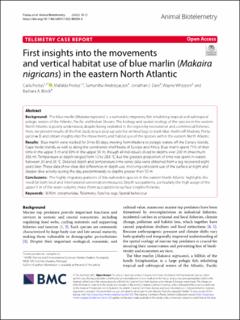| dc.contributor.author | Freitas, Carla | |
| dc.contributor.author | Freitas, Mafalda | |
| dc.contributor.author | Andrzejaczek, Samantha | |
| dc.contributor.author | Dale, Jonathan J. | |
| dc.contributor.author | Whippen, Wayne | |
| dc.contributor.author | Block, Barbara A. | |
| dc.date.accessioned | 2022-06-20T11:09:52Z | |
| dc.date.available | 2022-06-20T11:09:52Z | |
| dc.date.created | 2022-05-03T10:25:55Z | |
| dc.date.issued | 2022 | |
| dc.identifier.citation | Animal Biotelemetry. 2022, 10 (1), 1-9. | en_US |
| dc.identifier.issn | 2050-3385 | |
| dc.identifier.uri | https://hdl.handle.net/11250/2999565 | |
| dc.description.abstract | The blue marlin (Makaira nigricans) is a vulnerable migratory fish inhabiting tropical and subtropical pelagic waters of the Atlantic, Pacific and Indian Oceans. The biology and spatial ecology of the species in the eastern North Atlantic is poorly understood, despite being exploited in the region by recreational and commercial fisheries. Here, we present results of the first study to use pop-up satellite archival tags to track blue marlin off Madeira, Portugal (n = 3) and obtain insights into the movements and habitat use of the species within the eastern North Atlantic. | en_US |
| dc.language.iso | eng | en_US |
| dc.title | First insights into the movements and vertical habitat use of blue marlin (Makaira nigricans) in the eastern North Atlantic | en_US |
| dc.title.alternative | First insights into the movements and vertical habitat use of blue marlin (Makaira nigricans) in the eastern North Atlantic | en_US |
| dc.type | Peer reviewed | en_US |
| dc.type | Journal article | en_US |
| dc.description.version | publishedVersion | en_US |
| dc.source.pagenumber | 1-9 | en_US |
| dc.source.volume | 10 | en_US |
| dc.source.journal | Animal Biotelemetry | en_US |
| dc.source.issue | 1 | en_US |
| dc.identifier.doi | 10.1186/s40317-022-00284-0 | |
| dc.identifier.cristin | 2020875 | |
| cristin.ispublished | true | |
| cristin.fulltext | original | |
| cristin.qualitycode | 1 | |
